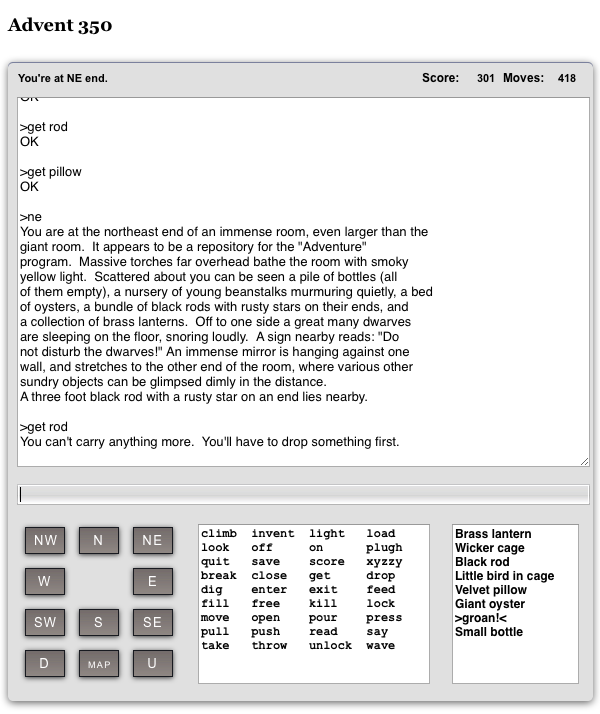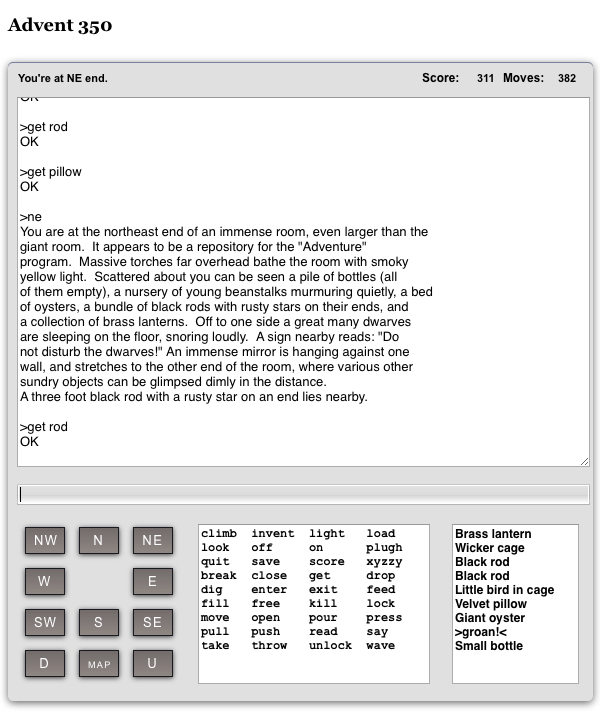A bug in Adventure’s endgame
WARNING: This post contains major spoilers related to the endgame of Crowther and Woods’ original Adventure! Do not proceed unless you’re okay with this.
The other day, Jonathan Ellis reported to me a bug in my C port of Crowther and Woods’ 350-point Adventure. (You can play my port online here.) The bug had to do with bookkeeping the player’s carrying capacity. I fixed it and then went over the code with a fine-toothed comb to verify the absence of other similar bugs… and lo and behold, I found a previously unknown(?) bug in the endgame of Crowther and Woods’ original game!
The first thing to know about Adventure’s bookkeeping is that it tracks
the player’s inventory in two redundant ways. First, location -1 is the
“in hand” location. If you want to find out whether the player is toting
the gold nugget, you just check whether PLACE(NUGGET).EQ.-1. (In fact,
Don Woods refactored this into a subroutine
so you can just check TOTING(NUGGET).) Second, the game tracks the
absolute number of objects toted by the player; each time the player picks
up or drops an item, we increment
or decrement the global variable HOLDNG. This second method was added
by Don Woods; in the only surviving copy of Crowther’s Fortran code,
HOLDNG does not exist. Woods added the two features of Adventure
that depend on HOLDNG: the player’s seven-object carrying capacity
and the Plover Room puzzle.
Spoiler alert: We’re going to find a way to get
HOLDNGout of sync withTOTING.
The original Adventure has exactly two “containers” — the wicker cage
and the water bottle. The cage can contain only the bird; the bottle can
contain either water or oil. (In Crowther’s source, you could empty
the bottle via POUR or DRINK, but then it would remain empty forever after.
Woods added both the OIL object, and the ability to refill the bottle in
various locations.)
Crowther’s cage-and-bird system is pretty simple: if you GET BIRD when the bird
is already in the cage, then you also pick up the cage, and vice versa.
(And similarly for dropping the cage.) In all other respects, the bird and
cage behave like ordinary totable items. In particular, they each individually
increment and decrement HOLDNG. If you’re carrying six objects and you try to
GET CAGE, you’ll succeed (because you haven’t yet reached your inventory limit
of 7 objects), resulting in HOLDNG.EQ.8. This is fine.
Crowther’s bottle-and-liquids system works completely differently! In Crowther’s
original source code, BOTTLE and WATER were synonymous; there was no “water”
in the game except for what started in the bottle.
Whether the bottle was “full of water” or not was controlled by PROP(WATER) —
0 meant “full” (its initial state), and 1 meant “empty.”
When Woods added the ability to refill the bottle via GET WATER — and for that
matter to DRINK WATER from the stream in the absence of any bottle — it suddenly
became important to have two distinct nouns BOTTLE and WATER. So Woods renamed
Crowther’s WATER object to BOTTLE, and added new objects for the two liquids
WATER and OIL. The liquid contents of the bottle are controlled by
PROP(BOTTLE) — 0 means “full of water,” 1 means “empty,” and 2 means “full of oil.”
But, in addition, the game updates PLACE(WATER) and PLACE(OIL) so that they
are “in hand” at the appropriate times. When the bottle is full of water and you
pick up the bottle, PLACE(WATER) becomes -1 (the “in hand” location).
When you drop the bottle or empty it, PLACE(WATER) becomes 0 (the “limbo” location).
The liquid objects OIL and WATER do not contribute to the player’s HOLDNG count!
You can FILL BOTTLE (or even GET WATER) even when HOLDNG.GE.7.
This means that Woods had to do some “clever” fixups in various places. For example,
in the code for the DROP verb:
9021 K=LIQ(0)
IF(K.EQ.OBJ)OBJ=BOTTLE
IF(OBJ.EQ.BOTTLE.AND.K.NE.0)PLACE(K)=0
IF(OBJ.EQ.CAGE.AND.PROP(BIRD).NE.0)CALL DROP(BIRD,LOC)
IF(OBJ.EQ.BIRD)PROP(BIRD)=0
CALL DROP(OBJ,LOC)
GOTO 2012
Calling DROP(OBJ,LOC)
decrements HOLDNG. Notice that if you DROP CAGE while the bird is in the cage,
we call DROP twice; but if you call DROP BOTTLE while the water is in the bottle,
we call DROP only once, and then use direct assignment to PLACE(K) to send the WATER
object back to limbo without decrementing HOLDNG.
This cleverness needs to be replicated in every place that puts liquids into your inventory
or takes them out again — GET, DROP, THROW, FILL, POUR, and even
death.
IF(NUMDIE.EQ.MAXDIE.OR..NOT.YEA)GOTO 20000
PLACE(WATER)=0
PLACE(OIL)=0
IF(TOTING(LAMP))PROP(LAMP)=0
DO 98 J=1,100
I=101-J
IF(.NOT.TOTING(I))GOTO 98
K=OLDLC2
IF(I.EQ.LAMP)K=1
CALL DROP(I,K)
98 CONTINUE
The code for death first sends WATER and OIL to limbo; then turns off your lamp; then drops
every toted object in the place where you died, except for the lamp, which (if toted) gets dropped
at the starting location instead. It is very important that we set PLACE(WATER)=0 before looping
over your possessions — otherwise we’d drop WATER in the place where you died, which would violate
our invariant that the liquid WATER is only ever found in location 0 (“limbo”) or location -1
(“in hand”). Plus, if we ever called DROP(I,K) with I.EQ.WATER, we’d decrement HOLDNG, and
that breaks our invariant that liquids don’t contribute to HOLDNG.
Where else do we DROP everything toted by the player?
When we teleport the player into the endgame repository!
LOC=115
OLDLOC=115
NEWLOC=115
[...]
PROP(MIRROR)=PUT(MIRROR,115,0)
FIXED(MIRROR)=116
DO 11010 I=1,100
IDONDX=I
11010 IF(TOTING(IDONDX))CALL DSTROY(IDONDX)
CALL RSPEAK(132)
CLOSED=.TRUE.
GOTO 2
DSTROY(OBJ) is a synonym for MOVE(OBJ,0), which is implemented in terms of DROP.
So, if when the flash of light happens the player is carrying a non-empty bottle — and therefore
TOTING some liquid — the liquid will be DSTROYed instead of manually sent to limbo;
which means the player’s HOLDNG count will be decremented one too many times; which means
that the player will enter the endgame TOTING zero objects but with HOLDNG.EQ.-1.
A player in this situation effectively has their inventory limit increased by 1!
And, coincidentally, there just happen to be exactly eight totable objects in the endgame: the bottle, oyster, lamp, cage, bird, pillow, and both black rods. So this bug’s effects are observable — just barely!
Here are screenshots I took of the original game emulated on Scott Healey’s excellent gobberwarts.com, as seen previously in “Colossal Cave Adventure: open world challenge” (2019-01-28). Notice the inventory lists in the lower right corner: in one case I’m able to pick up the second rod as my eighth item, and in the other case I’m not.
 |
 |
I have fixed this bug in my own C port — as well as the bug Jonathan Ellis actually reported, which was that my own port had stupidly had this same kind of bug any time you dropped a non-empty bottle at all. (My bug not only could be exploited to increase your carrying capacity ad infinitum, but caused very obvious misbehavior of the plover passage. Woods’ endgame bug has no such dramatic applications.)
I have also reported the bug “upstream” to Donald Knuth, whose brilliantly annotated CWEB version of Adventure served as the starting point for my own port. Knuth’s version faithfully replicated Woods’ original bug.
